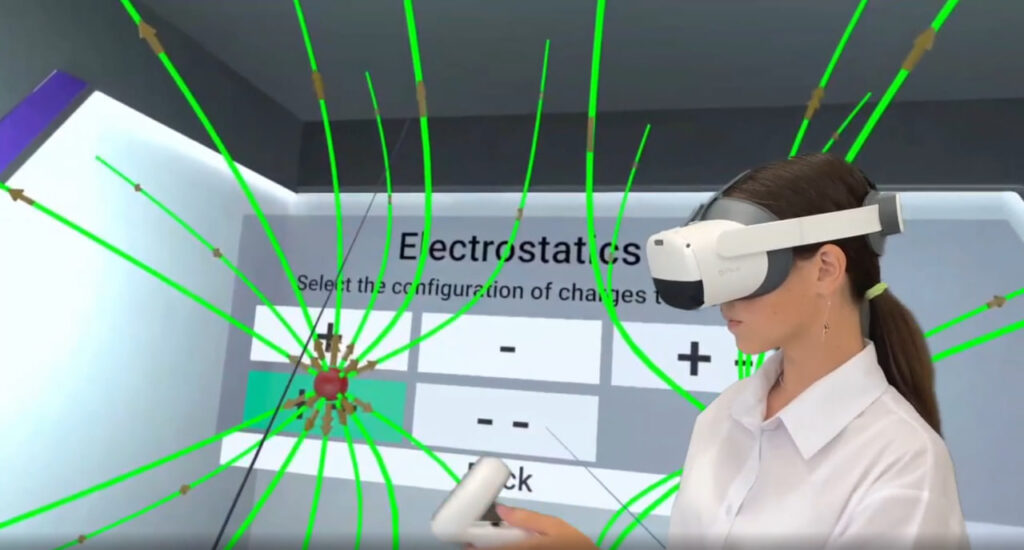

Studying physics can be an exciting journey, especially when we move beyond textbooks and into immersive, interactive experiences. That’s exactly where VR physics shines. Whether you’re following the physics Cambridge curriculum, physics IB, physics Indian curriculum CBSE, or physics NGSS, virtual reality offers a powerful way to understand complex concepts like electrification and Coulomb’s Law.
Below, we’ll explore how XReadyLab simulations bring electrical phenomena to life—complete with charged particles, force vectors, and even frictional contact. By the end of this article, you’ll see why this approach isn’t just for electricity units; it’s reshaping how we learn topics like diffraction and optics, too.
In many STEM lab environments, learners are restricted by physical limitations: lab schedules, equipment costs, and safety concerns. However, virtual reality in education opens up a world of possibilities, providing interactive classrooms that can simulate environments and phenomena in real time. This allows for:
These benefits align with international standards—be it the National curriculum in England, the physics National curriculum of the Netherlands, or Scuola secondaria in Italia—because the core scientific principles remain consistent across all these curricula.

XReadyLab offers an electrification simulation specifically designed to illustrate three fundamental ways objects become electrically charged: friction, contact, and influence. By using headsets like Meta Quest or Pico Neo 3, learners gain a front-row seat to these otherwise invisible processes.
Key Features:
Why It’s Important: Understanding frictional and contact electrification helps students grasp how static charges form in everyday life—from walking on carpets to brushing hair. Seeing these charges move in a VR classroom demystifies a topic usually confined to dull diagrams.

Another pivotal concept in physics is Coulomb’s Law, which describes how charged particles exert forces on each other. With XReadyLab’s Coulomb’s Law simulation, you can manipulate two charged spheres, alter their charge magnitudes, and observe the resulting electrostatic forces.
Standout Features:
Educational Impact: By visually representing the forces and vector directions, students see that electricity is not just theoretical—it’s a dynamic interaction. This kind of VR education meets Next-Generation Science Standards (NGSS) and benefits any learner aiming to master the core ideas of electrostatics.
Not only does the electricity curriculum benefit from virtual reality, but optics also gains a new dimension in VR classrooms. A prime example is diffraction, where you can visualize light bending around edges or through narrow slits. At XReadyLab, you can explore our diffraction simulation—included in our demo package—and see how immersive technology enhances understanding of wave behavior.
Ready to experience VR’s full potential across multiple scientific domains?
Request your free demo now to step into a new era of interactive STEM learning!
Why This Matters:

VR classrooms fit seamlessly into numerous educational environments, from physics IB labs to public high schools aligned with physics NGSS. The flexibility of these simulations means you can adapt the difficulty and scope, whether your class is exploring fundamental electrostatics or diving deeper into advanced wave phenomena.
Key Takeaways:
By blending the precision of physics curricula (like the physics National curriculum of the Netherlands or Scuola secondaria in Italia) with the immersion of virtual reality, we’re creating an education VR system that puts students at the center of discovery. XReadyLab’s simulations on electrification and Coulomb’s Law show how the invisible world of charges becomes tangible, making science more exciting and comprehensible.
And the journey doesn’t stop at electricity—optics simulations like diffraction broaden the scope, proving that VR models aren’t just a novelty; they’re a transformative leap in how we teach and learn STEM. With these immersive tools, students around the globe can move from passive observation to active experimentation, unleashing a new era of interactive class experiences.
Frequently Asked
We prodive VR biology, VR physics, and VR chemistry simulations. Please, check our catalog.
Please, fill the form to get demo labs for free.
Please contact our customer support service at support@xreadylab.com or book a call with the team to find out the conditions and book the VR class set up at your school.
Subscription to XReady Lab interactive VR labs. If you are a school, then you are also given access to the VR classroom system. VR class system helps you easily launch VR lessons for a large number of students, follow the experience of each student, as well as customise the content without developers.
We adhere to the world’s generally accepted recommendations and research. Our products are suitable for children from 12 years old.